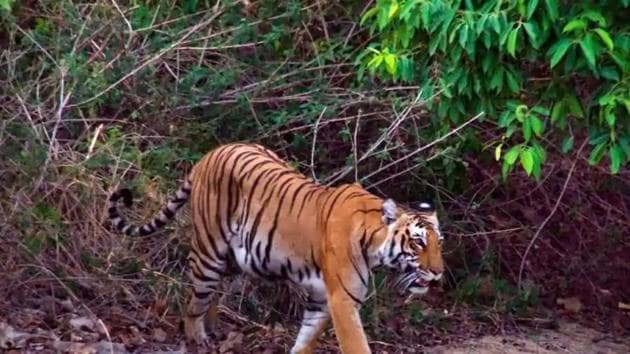First tiger translocation in Uttarakhand from Corbett to Rajaji Tiger Reserve in October
Initially, five tigers, including two young males and three females, will be shifted in a phased manner to Rajaji’s western part that has not reported any breeding of the animals in about a decade.
A young male tiger would be translocated for the first time in Uttarakhand from Corbett Tiger Reserve to Rajaji Tiger Reserve’s western part in the first week of October in a bid to increase the big cat’s population in the reserve, forest officials said.

Amit Verma, director, Rajaji Tiger Reserve, said the translocation of tigers is a first-of-its-kind move.
Initially, five tigers, including two young males and three females, will be shifted in a phased manner to Rajaji’s western part that has not reported any breeding of the animals in about a decade.
Corbett’s tiger population is around 260, the officials added.
“Tigers must have been caught from human habitation areas and released into the wild. But systematic translocation via the soft and hard release in a bid to increase their population in a certain landscape is happening for the first time in the state,” said Verma.
AG Ansari, a wildlife expert, agreed with Verma.
However, he said that gharials had been re-introduced in the 1970s, when the state was still a part of Uttar Pradesh (UP).
“Translocation of tigers has never taken place in Uttarakhand. However, when the state was still a part of UP, gharials were reintroduced from Lucknow’s Kukrail breeding centre,” said Ansari.
The director said that the Central government has released around Rs 40 lakh this year for translocation-related activities.
“The Central government has released Rs 40 lakh for translocation-related activities such as procuring appropriate cages, identification process of tigers, etc. The translocation process is likely to be carried out in the first week of October,” said Verma.
The identification process of the five tigers that are tipped to be translocated would begin soon. Intensive camera trapping exercise would be carried out in certain ranges of Corbett to identify the tigers that would be transported in a phased manner. Veterinarians would tranquillise the shortlisted tigers before they are translocated, he added.
Rajaji has 34 resident tigers, including 32 in its eastern part, which is spread across 150 square (sq) kilometres (km) and two tigresses in the western part that covers 570 sq km.
Last September, a team from the National Tiger Conservation Authority (NTCA) had visited Rajaji to conduct reconnaissance for the translocation exercise and had suggested a soft release of a pair of tigers in the reserve’s western side.
“Both the soft and hard release can be done, because of the dense vegetation in the reserve’s western part. But the soft release is preferred, as the animals can undergo check-ups for any disease before they are set free in the wild,” Anup Nayak, member-secretary, NTCA, had said after the recce.
A busy traffic corridor divides the eastern and the western part of the reserve and acts as a stumbling block for tigers’ free movement.






